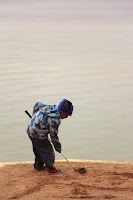WHEN it comes to isolated
settlements, Pond Inlet must be near the top of the list.
This village, on the northern
end of Baffin Island near the famed Northwest Passage, is hundreds of
kilometres from anywhere with the isolation only emphasised during the long
Arctic winters when the sun doesn't shine on the hamlet for months at a time.
We called into Pond Inlet for a
few hours today and were treated to a very warm welcome by the residents of this proud Inuit community.
The elders – keen to make the most
of the rare visits by cruise ships and expedition boats – organised a
performance to showcase traditional music, dance, singing and costumes.
There was even a display of
throat singing, a traditional Inuit art where a pair of women make high and low
sounds deep in their throat and alternate so those listening can only hear one
long note.
Clipper Adventurer culturalist
Jenna Andersen gave the passengers a lesson on throat singing when we returned
to the ship.
"Two women stand facing
each other, holding each other's elbows, and stare at each other," she said.
"They make the sounds from the
hard part of the throat, adding in higher notes, and whoever laughs first or
messes up would lose the competition.
"The women know how to throat
sing and it used to be a competition, but that has changed over the years and
now it's a cultural thing and a celebration rather than a contest.''
Pond Inlet was another of those
Arctic communities developed so the residents of remote communities could come together
to be cared for and while the Inuit has paid a big price, sacrificing the
traditional way of life, the people have managed to hold on to some customs.
One of my favourites, and something
we got to see during our afternoon in Pond Inlet, was the amautik which is an
oversized poncho new mothers wear to carry their baby keeping the infant close
to their body at all times.
Jenna Andersen, who is a resident of a
remote northern community – the only way in to her village when she was
growing up was by boat or seaplane – told the group an infant could stay
in the traditional coverall for as long as two years.
"Inuit women work their hearts
out," she explained.
"They prepare all the meals, they
sew everything for the community, and they look after the tent area and having
their baby behind them means the child is always with the mother but she has
her hands free to work.
"And, while it's an item of
clothing worn by the women in the community, a man will wear his wife's amautik
for a couple of weeks if he's having no luck hunting because it will help him
reconnect to the land."
When we got back to the ship I spent some time braving the cold on deck to take in the view across the water to the Sirmilik National Park.
This protected parcel of land occupies the whole island across the channel from Pond Inlet, as well as a tip of Baffin island just to the west of the settlement, and it's one of three national parks in this part of the Canadian Arctic.
While any parcel of wilderness is special I marvelled at this one because of the number of glaciers I could see from the deck of the Clipper Adventurer.
I have travelled great distances in the past to see one glacier - there was a day in The Yukon a few years back when I travelled north from Whitehorse to fly over a glacier just across the border in Alaska - but today all I had to do was stand on the deck to see a dozen rivers of ice.
Almost everywhere else in the world a glacier is a big deal, but when there are dozens just across the water it seems they become very common and unexciting with the locals finding it hard to understand why I was so impressed with the view from their town.
























